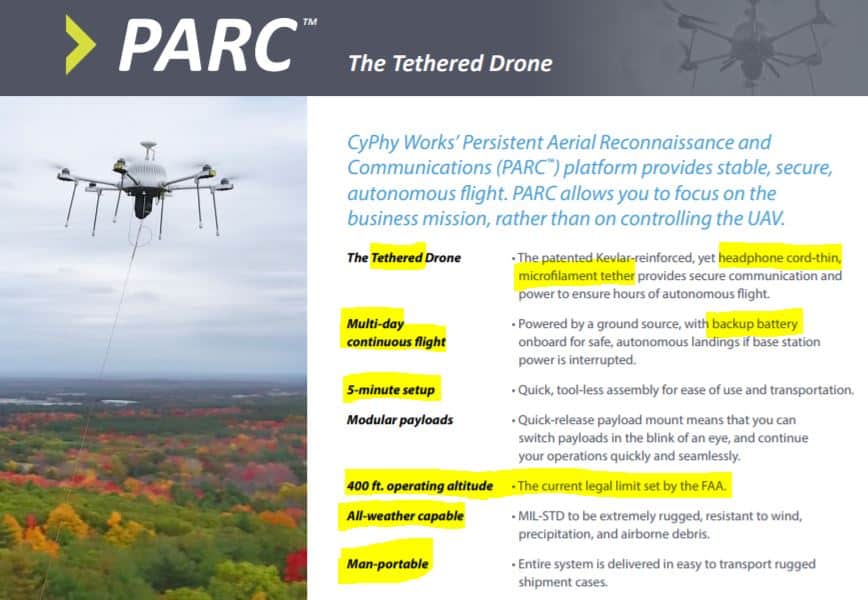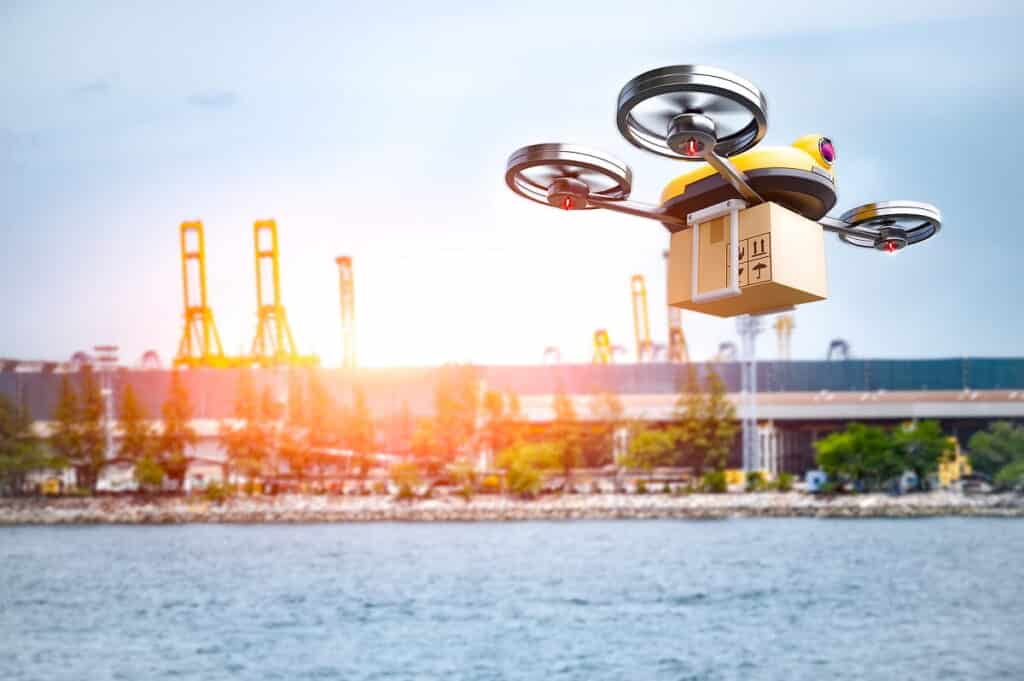7 Startups Using Drones for Inspections & Monitoring
Table of contents

According to an article by Phys.org, the U.S. Department of Transportation says that there is a $808.2 billion backlog of investment spending for bridges and highways, including $479.1 billion in critically needed repairs. More than two-thirds of the nation’s roads and nearly 143,000 bridges are classified in “dire need” of repair or upgrades. One way to expedite all the inspections needed to arrive at these numbers is by using drones. While we’ve covered industrial drones in the past, this time we’re interested in looking at industrial drones for inspections.
The FAA is working on regulations for unmanned drone flight right now, but they haven’t released a firm timetable on these regulations. This has left many industries on hold, waiting for regulations that will allow them to use drones for things like deliveries or security. However, the inspections industry is one that doesn’t actually need to wait for these regulations to be in place. For most inspection applications, the drones do not need to leave the operator’s line of sight which reduces a key concern that the FAA has about potential unmanned aircraft. This makes drone inspection services legal under current regulations. Below you can see a subset of drone inspection companies on this great market map from CB Insights:
Let’s take a look at the 7 drone inspection startups above that are changing the way that we inspect and deal with construction and infrastructure problems:
Drone Inspection for Insurance
We’ve been talking quite a bit lately about “insurtech“, in particular, focusing on the use of (AI) to better streamline the insurance process. BetterView wants to offer a drone inspection service that primarily targets the insurance industry. The Company has raised $1.55 million through three rounds of equity funding to date to offer comprehensive services to the insurance industry. At the forefront of their products is the “BetterView Platform” which offers a complete insurance underwriting system that includes modules for training employees, assessing buildings, planning drone flights, and capturing and analyzing data.
While that seems like way too much work, BetterView takes a preliminary look at satellite images like those from Cape Analytics and then decides if you need a closer inspection with drones. They’ll either give you the DJI drones to fly yourself or make their own drone operators available to you at an additional cost (Drone Inspection as a Service?).
Update 05/28/2019: Betterview has raised $4.5 million in Series A funding to grow their team. This brings the company’s total funding to $8.1 million to date.
Inspecting Wind Turbine Blades
There are more than 53,00o wind turbines operating in the United States right now, and a startup out of Ann Arbor Michigan called SkySpecs offers autonomous drone solutions that allow for efficient methods to inspect critical wind energy infrastructure. The startup has raised $3.5 million through two rounds of equity funding to date and primarily markets an automated system that inspects wind turbine blades. Why not just get some bloke to climb up there and take a peak? Mainly because these windmills are now bigger than an Airbus:
By pushing a single button, companies can launch a drone that flies around collecting data from all sides of a 3-blade turbine. A complete inspection of a single wind turbine is possible in less than 15 minutes, with the data analyzed and delivered within 48 hours.
A Roughneck That Runs on Batteries

A Drone That Doesn’t Come Down
Up until now, we’ve been talking about drones that run on powerful lithium batteries, but this startup makes a drone that’s “tethered” meaning it has a cable connecting into the ground. Why would you choose to do that? Mainly because these things can stay in the air for nine day straight days at a height of 400 feet.
You may have heard of the founder and CTO before, Helen Greiner. No, it’s not because she’s been on the cover of every woman’s magazine for her accomplishments in technology, it’s because she’s also the co-founder of perhaps the most popular robot stock there is right now, iRobot (NASDAQ:IRBT). (Not to stray too far off topic here but iRobot seems to be suffering from a bit of robo-hype with shares up 130% in the past year.) Investors have a great deal of confidence in Greiner’s vision having given her $36 million through 5 rounds of equity funding to date for a platform called the “Persistent Aerial Reconnaissance and Communications” or PARC. The main focus is to offer persistent autonomous unmanned drone flights that can be rapidly deployed, designed to operate in high winds, and also able to carry cargo up to four pounds, making it a great solution for inspections in industrial settings. CyPhy Works also offers their Data Platform which provides rich real-time flight video (that cable provides data streaming in addition to power), cloud-access, remote monitoring and flight operation management among other features.
Reduce Your Workers Comp Lawsuits
Imagine a drone that can crash into stuff without causing any damage. That’s the idea behind Flyability, a startup that has developed what they call the “world’s first collision-proof flying robot”. They aim to reduce risk and cut costs for inspections and security applications using drones, and have raised a total of $6.79 million through three rounds of equity funding to date. The Flyability drones are designed for inspecting tight spaces where light collisions are likely.
Imagine you run a nuclear power plant and because of all the regulations, you need to inspect the thing almost constantly it seems. You can’t just send any old engineer in there because they all have limits to how much radiation they can be exposed to. Why not just send in Elios? This was a case study that actually took place where Elios was used to inspect tank rooms at a nuclear power plant, a task that was reduced from 1.5 hours down to less than 15 minutes. Below are some of the pictures it took while inspecting:
Now imagine you can save $460,000 in potential “lost income” and at the same time reduce the likelihood of workers suing you provide a safer environment for your greatest assets, your employees, by replacing their most dangerous tasks with flying robots. This is a win-win people.
Update 11/17/2018: Flyability has raised $11 million in Series B funding to continue creating the future of autonomous indoor inspection. This brings the company’s total funding to $17.8 million to date.
Checking Out Power Lines
Sharper Shape provides drone solutions to companies that hold infrastructure and utility assets, and has raised $4.43 million in equity funding through three rounds of funding so far. If you go outside of big cities and travel on the interstate, you’ll often see large electrical transmission towers carrying electricity cables across long distances. Inspecting these towers is a main focus of Sharper Shape, and their comprehensive services include drone piloting and data reporting. You can save up to 30% in inspection costs and receive a report in just 2 days. They are a self-proclaimed “global leader”, and have logged over 1,000 successful missions with more than 10,000 total flight hours with operational partners. The startup recently announced a partnership with Sterlite Power (large Indian utility company) for inspecting and analyzing power company assets in India.
Elementary My Dear Watson
This next startup may not be a global leader but they do offer “the world’s most versatile commercial drone”. Aerialtronics is a Holland-based startup that offers a drone with a 40-minute flying time that companies can use for inspection, mapping, agricultural, and public safety applications. Having raised $4.09 million through one round of funding to date, the main selling point here is the use of AI for running inspections on things like powerlines, telecom towers, and yes, wind turbines. Their “artificial intelligence inspection system” uses none other than IBM’s Watson to manage flights and find defects in critical systems. Their partners include Nokia and T-Mobile.
Conclusion
Looks like we don’t need to wait for drone regulations to get sorted out before moving forward with some very cool applications for drones, in this case, drones for inspection and monitoring. While these were all pretty interesting startups, we were particularly intrigued by CyPhy and their tethered drone offering. If that thing just sits in one place and doesn’t move, are they still required to have someone watching it? We can just see these drones being deployed for niche uses outside of inspecting like playing traffic cop, providing video coverage for road races, or keeping tabs on a secured perimeter – maybe even one that’s 2,000 miles long.
Sign up to our newsletter to get more of our great research delivered straight to your inbox!
Nanalyze Weekly includes useful insights written by our team of underpaid MBAs, research on new disruptive technology stocks flying under the radar, and summaries of our recent research. Always 100% free.


















